- Clone
- K041E5 (See other available formats)
- Regulatory Status
- RUO
- Other Names
- BONZO, STRL33, TYMSTR
- Isotype
- Mouse IgG2a, κ
- Ave. Rating
- Submit a Review
- Product Citations
- publications
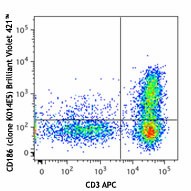
-

Human peripheral blood mononuclear cells were stimulated with IL-2 for 9 days, and then stained with CD3 APC and CD186 (clone K041E5) Brilliant Violet 421™ (top) or mouse IgG2a, κ Brilliant Violet 421™ isotype control (bottom). -

| Cat # | Size | Price | Quantity Check Availability | Save | ||
|---|---|---|---|---|---|---|
| 356013 | 25 tests | 215 CHF | ||||
| 356014 | 100 tests | 435 CHF | ||||
CD186, also known as CXCR6, is a 39 kD, G-protein coupled chemokine receptor, with seven transmembrane-spanning regions. CXCR6 is expressed on activated and memory T cells. Its ligand is the chemokine CXCL16. CXCR6 is involved in the recruitment of cells to inflamed sites and is also a coreceptor for HIV.
Product DetailsProduct Details
- Verified Reactivity
- Human
- Antibody Type
- Monoclonal
- Host Species
- Mouse
- Immunogen
- cDNA encoding human CXCR6
- Formulation
- Phosphate-buffered solution, pH 7.2, containing 0.09% sodium azide and BSA (origin USA).
- Preparation
- The antibody was purified by affinity chromatography and conjugated with Brilliant Violet 421™ under optimal conditions.
- Concentration
- Lot-specific (to obtain lot-specific concentration and expiration, please enter the lot number in our Certificate of Analysis online tool.)
- Storage & Handling
- The antibody solution should be stored undiluted between 2°C and 8°C, and protected from prolonged exposure to light. Do not freeze.
- Application
-
FC - Quality tested
- Recommended Usage
-
Each lot of this antibody is quality control tested by immunofluorescent staining with flow cytometric analysis. For flow cytometric staining, the suggested use of this reagent is 5 µl per million cells in 100 µl staining volume or 5 µl per 100 µl of whole blood.
Brilliant Violet 421™ excites at 405 nm and emits at 421 nm. The standard bandpass filter 450/50 nm is recommended for detection. Brilliant Violet 421™ is a trademark of Sirigen Group Ltd.
Learn more about Brilliant Violet™.
This product is subject to proprietary rights of Sirigen Inc. and is made and sold under license from Sirigen Inc. The purchase of this product conveys to the buyer a non-transferable right to use the purchased product for research purposes only. This product may not be resold or incorporated in any manner into another product for resale. Any use for therapeutics or diagnostics is strictly prohibited. This product is covered by U.S. Patent(s), pending patent applications and foreign equivalents. - Excitation Laser
-
Violet Laser (405 nm)
- Product Citations
-
- RRID
-
AB_2562514 (BioLegend Cat. No. 356013)
AB_2562514 (BioLegend Cat. No. 356014)
Antigen Details
- Structure
- GPCR, seven transmembrane-spanning regions, 39 kD
- Distribution
-
Memory T cells, activated T cells
- Function
- Chemotaxis, coreceptor for HIV
- Ligand/Receptor
- CXCL16
- Cell Type
- T cells
- Biology Area
- Immunology
- Molecular Family
- CD Molecules, Cytokine/Chemokine Receptors, GPCR
- Antigen References
-
1. Kim CH, et al. 2001. J. Clin. Invest. 107:595.
2. Nanki T, et al. 2005. Arthritis Rheum. 52:3004.
3. Van der Voort R, et al. 2005. Arthritis Rheum. 52:1381.
4. Aust G, et al. 2005. Eur. J. Endocrinol. 152:635.
5. Agostini C, et al. 2005. Am. J. Respir. Crit. Care Med. 172:1290.
6. Gaida MM, et al. 2008. Clin. Exp. Immunol. 154:216.
7. Huang Y, et al. 2008. J. Immunol. 180:2367. - Gene ID
- 10663 View all products for this Gene ID
- UniProt
- View information about CD186 on UniProt.org
Related FAQs
- What is the F/P ratio range of our BV421™ format antibody reagents?
-
It is lot-specific. On average it ranges between 2-4.
- Does staining at room temperature or even at 37°C help for checking chemokine receptors expression?
-
Due to continuous recycling of many chemokine receptors, it may be worthwhile to consider staining at room temperature or at 37°C if the staining at lower temperature (which can potentially reduce receptor turnover) is not optimal.
Other Formats
View All CD186 Reagents Request Custom Conjugation| Description | Clone | Applications |
|---|---|---|
| Alexa Fluor® 647 anti-human CD186 (CXCR6) | K041E5 | FC |
| PE anti-human CD186 (CXCR6) | K041E5 | FC |
| Purified anti-human CD186 (CXCR6) | K041E5 | FC |
| APC anti-human CD186 (CXCR6) | K041E5 | FC |
| PerCP/Cyanine5.5 anti-human CD186 (CXCR6) | K041E5 | FC |
| PE/Cyanine7 anti-human CD186 (CXCR6) | K041E5 | FC |
| Brilliant Violet 421™ anti-human CD186 (CXCR6) | K041E5 | FC |
| PE/Dazzle™ 594 anti-human CD186 (CXCR6) | K041E5 | FC |
| Biotin anti-human CD186 (CXCR6) | K041E5 | FC |
| FITC anti-human CD186 (CXCR6) | K041E5 | FC |
| TotalSeq™-A0804 anti-human CD186 (CXCR6) | K041E5 | PG |
| TotalSeq™-C0804 anti-human CD186 (CXCR6) | K041E5 | PG |
| TotalSeq™-B0804 anti-human CD186 (CXCR6) | K041E5 | PG |
| Spark Red™ 718 anti-human CD186 (CXCR6) (Flexi-Fluor™) | K041E5 | FC |
Customers Also Purchased
Compare Data Across All Formats
This data display is provided for general comparisons between formats.
Your actual data may vary due to variations in samples, target cells, instruments and their settings, staining conditions, and other factors.
If you need assistance with selecting the best format contact our expert technical support team.
-
Alexa Fluor® 647 anti-human CD186 (CXCR6)
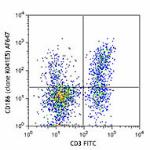
Human peripheral blood mononuclear cells were stimulated wit... 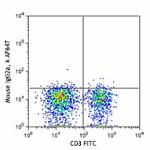
-
PE anti-human CD186 (CXCR6)
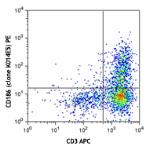
Human peripheral blood mononuclear cells were stimulated wit... 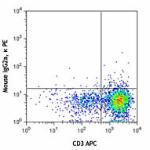
-
Purified anti-human CD186 (CXCR6)
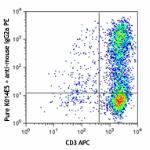
Human peripheral blood mononuclear cells were stimulated wit... 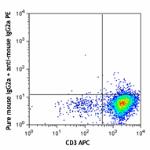
-
APC anti-human CD186 (CXCR6)
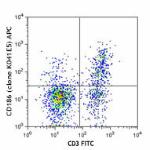
Human peripheral blood mononuclear cells were stimulated wit... 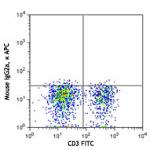
-
PerCP/Cyanine5.5 anti-human CD186 (CXCR6)

Human peripheral blood mononuclear cells were stimulated wit... -
PE/Cyanine7 anti-human CD186 (CXCR6)

Human peripheral blood mononuclear cells were stimulated wit... -
Brilliant Violet 421™ anti-human CD186 (CXCR6)
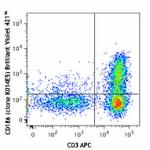
Human peripheral blood mononuclear cells were stimulated wit... 
-
PE/Dazzle™ 594 anti-human CD186 (CXCR6)

Human peripheral blood lymphocytes were stimulated with IL-2... -
Biotin anti-human CD186 (CXCR6)

Human Peripheral Blood Mononuclear Cells were stimulated wit... 
-
FITC anti-human CD186 (CXCR6)
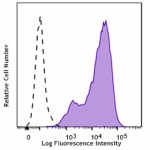
CXCR6-transfected CHO cells were stained with CD186 (CXCR6) ... -
TotalSeq™-A0804 anti-human CD186 (CXCR6)
-
TotalSeq™-C0804 anti-human CD186 (CXCR6)
-
TotalSeq™-B0804 anti-human CD186 (CXCR6)
-
Spark Red™ 718 anti-human CD186 (CXCR6) (Flexi-Fluor™)
 Login / Register
Login / Register 












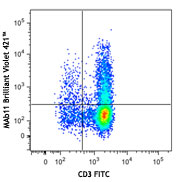
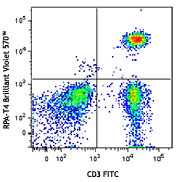
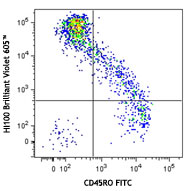



Follow Us